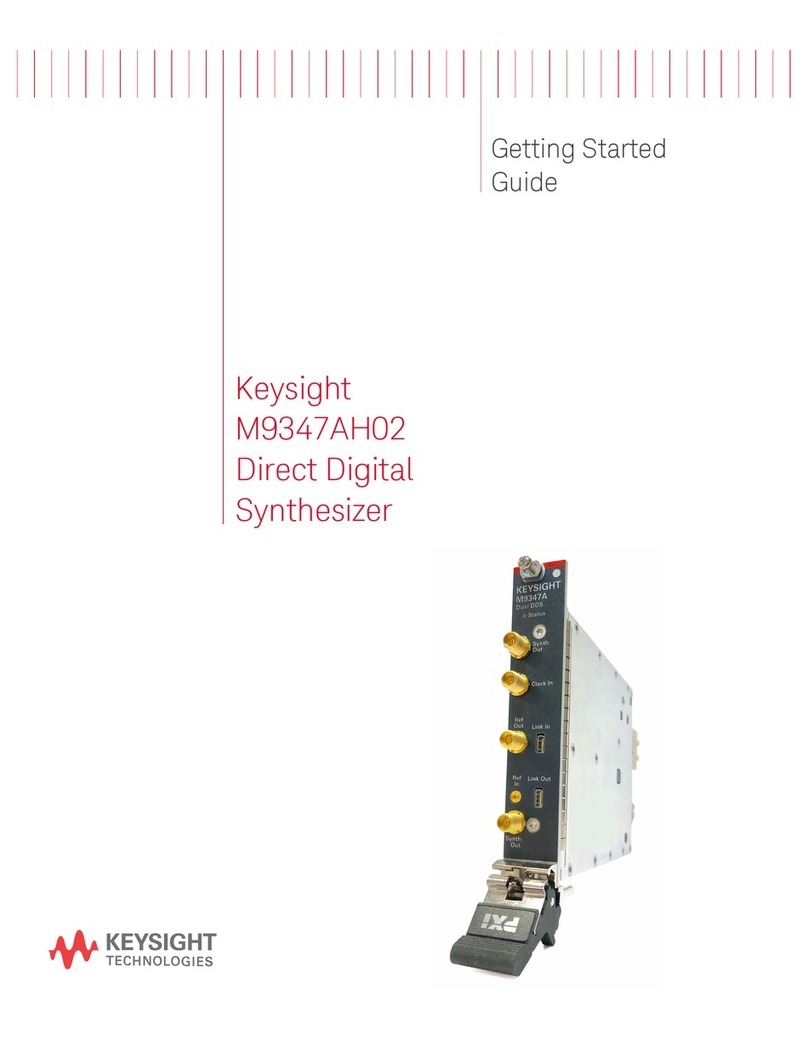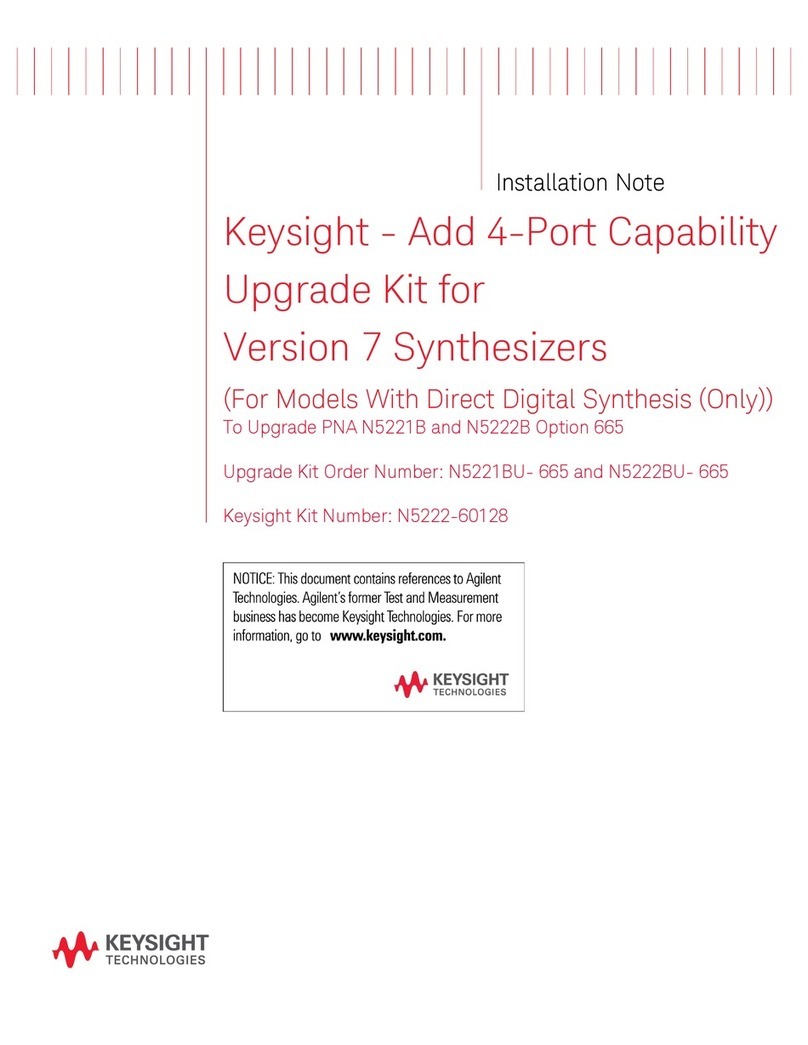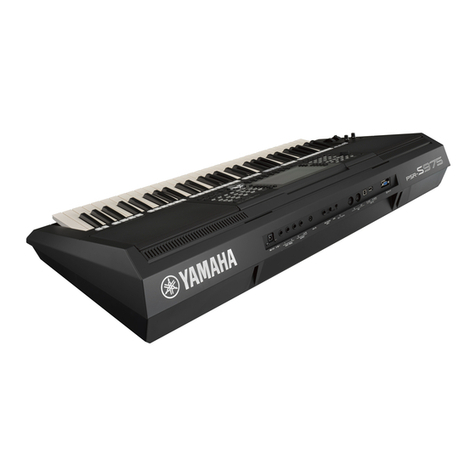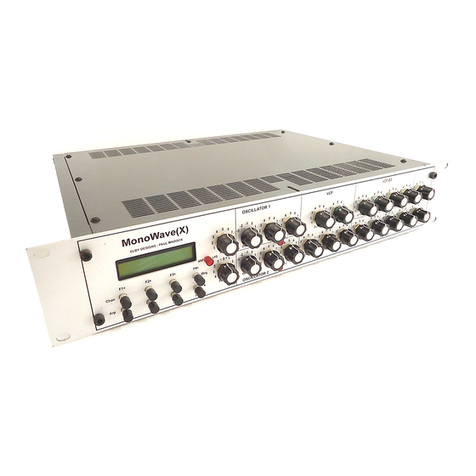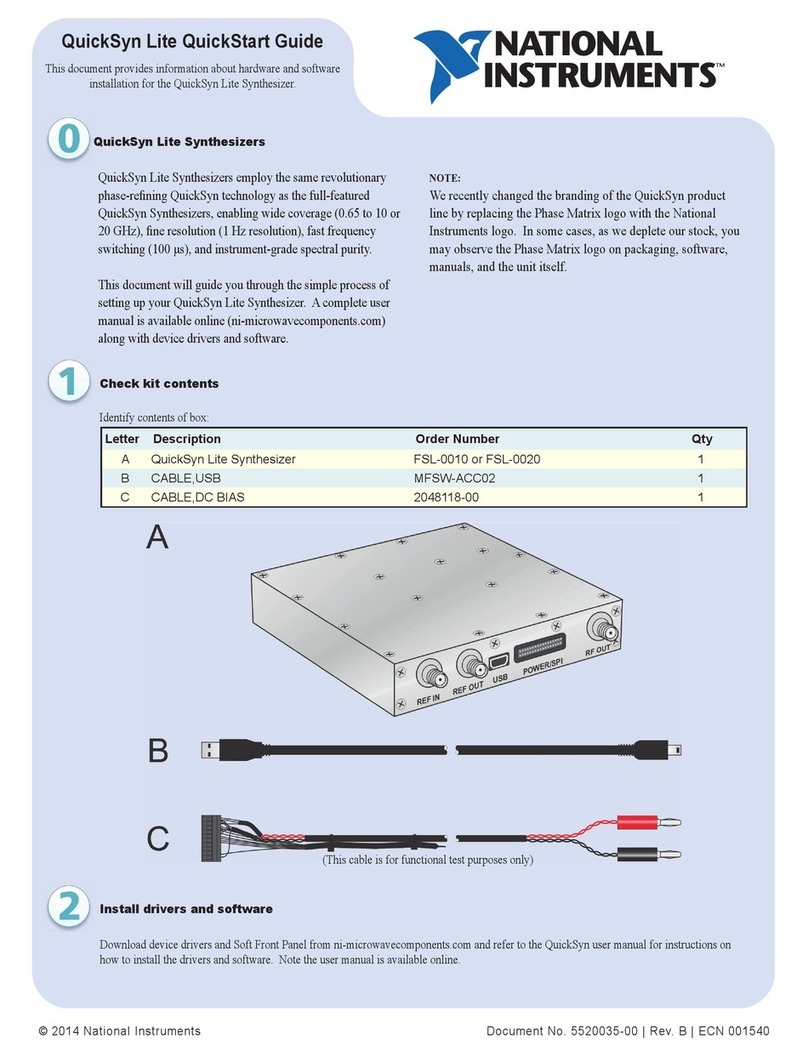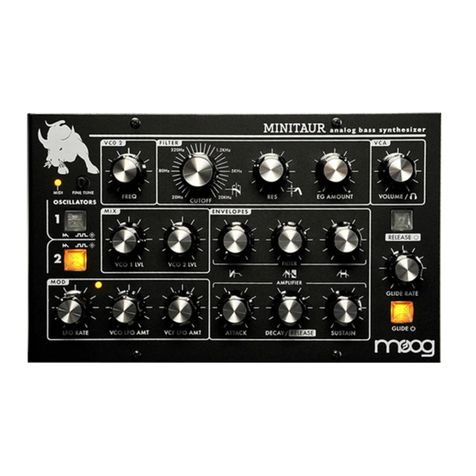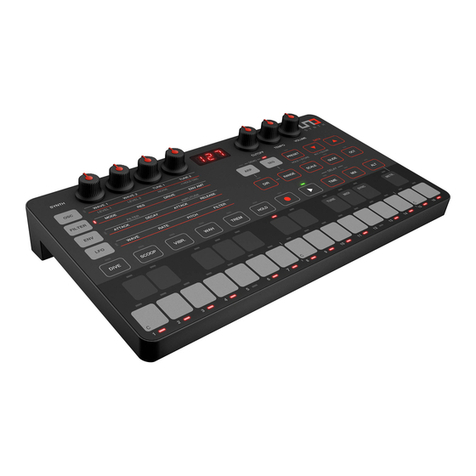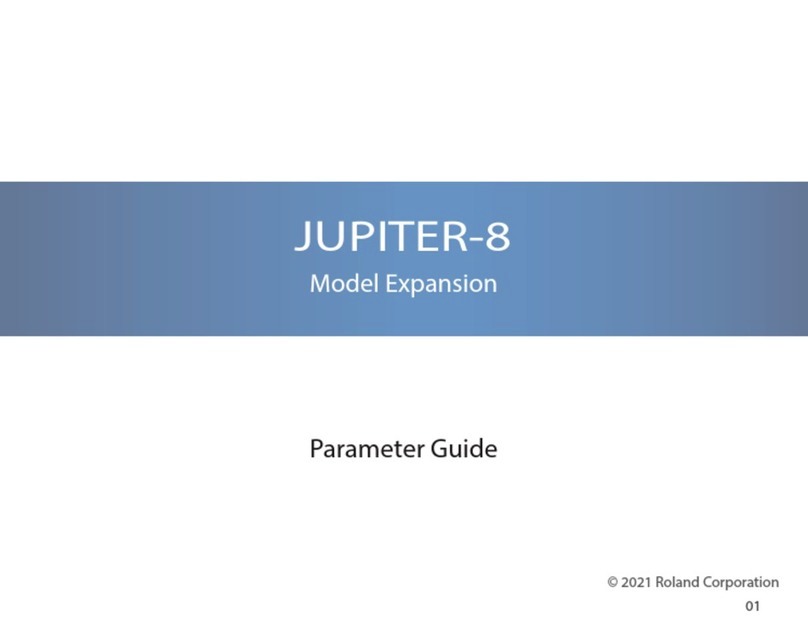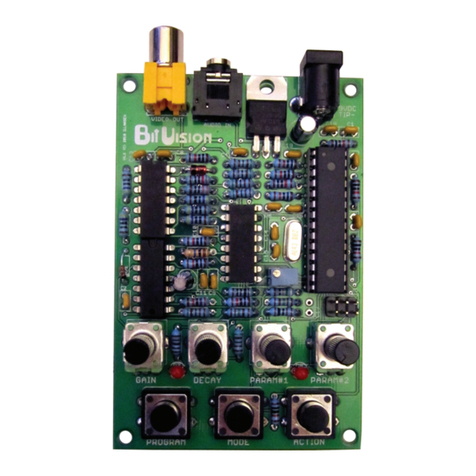Keysight Technologies N4963A User manual

User’s Guide
Keysight N4963A
Clock Synthesizer 13.5 GHz

Keysight N4963A
Clock Synthesizer 13.5 GHz
User Guide

Notices
© Keysight Technologies 2017
No part of this manual may be reproduced in any form
or by any means (including electronic storage and
retrieval or translation into a foreign language) without
prior agreement and written consent from Keysight
Technologies as governed by United States and
international copyright laws.
Manual Part Number
N4963-91021
Edition
Edition 3.0, October 2017
Keysight Technologies, Deutschland GmbH
Herrenberger Str. 130
71034 Böblingen, Germany
For Assistance and Support
http://www.keysight.com/find/assist
Limitation of Warranty
The foregoing warranty shall not apply to defects
resulting from improper or inadequate maintenance
by Buyer, Buyer-supplied software or interfacing,
unauthorized modification or misuse, operation
outside of the environmental specifications for the
product, or improper site preparation or maintenance.
No other warranty is expressed or implied. Keysight
Technologies specifically disclaims the implied
warranties of Merchantability and Fitness for a
Particular Purpose.
Warranty
The material contained in this document is provided
“as is,” and is subject to being changed, without
notice, in future editions. Further, to the maximum
extent permitted by applicable law, Keysight disclaims
all warranties, either express or implied, with regard to
this manual and any information contained herein,
including but not limited to the implied warranties of
merchantability and fitness for a particular purpose.
Keysight shall not be liable for errors or for incidental
or consequential damages in connection with the
furnishing, use, or performance of this document or of
any information contained herein. Should Keysight
and the user have a separate written agreement with
warranty terms covering the material in this document
that conflict with these terms, the warranty terms in
the separate agreement shall control.
Technology Licenses
The hardware and/or software described in this
document are furnished under a license and may be
used or copied only in accordance with the terms of
such license.
Restricted Rights Legend
If software is for use in the performance of a U.S.
Government prime contract or subcontract, Software
is delivered and licensed as “Commercial computer
software” as defined in DFAR 252.227-7014 (June
1995), or as a “commercial item” as defined in FAR
2.101(a) or as “Restricted computer software” as
defined in FAR 52.227-19 (June 1987) or any
equivalent agency regulation or contract clause. Use,
duplication or disclosure of Software is subject to
Keysight Technologies’ standard commercial license
terms, and non-DOD Departments and Agencies of the
U.S. Government will receive no greater than
Restricted Rights as defined in FAR 52.227-19(c)(1-2)
(June 1987). U.S. Government users will receive no
greater than Limited Rights as defined in FAR 52.227-
14 (June 1987) or DFAR 252.227-7015 (b)(2)
(November 1995), as applicable in any technical data.
Safety Notices
A CAUTION notice denotes a hazard. It
calls attention to an operating procedure,
practice, or the like that, if not correctly
performed or adhered to, could result in
damage to the product or loss of important
data. Do not proceed beyond a CAUTION
notice until the indicated conditions are
fully understood and met.
A WARNING notice denotes a hazard. It
calls attention to an operating procedure,
practice, or the like that, if not correctly
performed or adhered to, could result in
personal injury or death. Do not proceed
beyond a WARNING notice until the
indicated conditions are fully understood
and met.
A NOTE provides important or special
information.
CAUTION
WARNING

Safety Summary
General Safety Precautions
The following general safety precautions must
be observed during all phases of operation of
this instrument. Failure to comply with these
precautions or with specific warnings elsewhere
in this manual violates safety standards of
design, manufacture, and intended use of the
instrument.
Keysight Technologies assumes no liability for
the customer's failure to comply with these
requirements.
Before operation, review the instrument and
manual for safety markings and instructions.
You must follow these to ensure safe operation
and to maintain the instrument in safe
condition.
Initial Inspection
Inspect the shipping container for damage. If
there is damage to the container or cushioning,
keep them until you have checked the contents
of the shipment for completeness and verified
the instrument both mechanically and
electrically. The Performance Tests give
procedures for checking the operation of the
instrument. If the contents are incomplete,
mechanical damage or defect is apparent, or if
an instrument does not pass the operator’s
checks, notify the nearest Keysight Technologies
Sales/Service Office.
WARNING To avoid hazardous electrical shock,
do not perform electrical tests when there are
signs of shipping damage to any portion of the
outer enclosure (covers, panels, etc.).
General
This product is a Safety Class 1 product
(provided with a protective earthing ground
incorporated in the power cord). The mains plug
shall only be inserted in a socket outlet provided
with a protective earth contact. Any interruption
of the protective conductor, inside or outside of
the instrument, will make the instrument
dangerous. Intentional interruption is
prohibited.
Environment Conditions
This instrument is intended for indoor use in an
installation category II, pollution degree 2
environment per IEC 61010 Second Edition and
664 respectively. It is designed to operate
within a temperature range of 10 to 40 °C at a
maximum relative humidity of 80% for
temperatures up to 31 °C, decreasing linearly to
50% relative humidity at 40 °C at an altitude of
2000 meters.
This module can be stored or shipped at
temperatures between -40°C and +70°C.
Protect the module from temperature extremes
that may cause condensation within it.
Before Applying Power
Verify that all safety precautions are taken. The
power cable inlet of the instrument serves as a
device to disconnect from the mains in case of
hazard. The instrument must be positioned so
that the operator can easily access the power
cable inlet. When the instrument is rack
mounted the rack must be provided with an
easily accessible mains switch.
Ground the Instrument
Install the instrument so that the ON / OFF
switch is readily identifiable and is easily
reached by the operator. The ON / OFF switch is
the instrument disconnecting device. It
disconnects the mains circuits from the mains
supply before other parts of the instrument. Or
the detachable power cord can be removed from
the electrical supply. Alternately, an externally
installed switch or circuit breaker which is
readily identifiable and is easily reached by the
operator may be used as a disconnecting
device.
Do Not Operate in an
Explosive Atmosphere
Do not operate the instrument in the presence of
flammable gases or fumes.
Do Not Remove the
Instrument Cover
Operating personnel must not remove
instrument covers. Component replacement and
internal adjustments must be made only by
qualified personnel.
Instruments that appear damaged or defective
should be made inoperative and secured
against unintended operation until they can be
repaired by qualified service personnel.

Symbols on Instruments
The instruction documentation symbol. The product is
marked with this symbol when it is necessary for the
user to refer to the instruction in the documentation.
C-Tick Conformity Mark of the Australian ACA for EMC
compliance.
This mark indicates compliance with the Canadian
EMC regulations.
ISM 1-A
This text denotes the instrument is an Industrial
Scientific and Medical Group 1 Class A product.
CE Marking to state compliance within the European
Community: This product is in conformity with the
relevant European Directives. EMC Directive
2004/108/EC and Low Voltage Directive
2006/95/EC.
This symbol indicates that internal circuits can be
damaged by electrostatic discharge (ESD), therefore,
avoid applying static discharges to the panel input
connectors.
China RoHS regulations include requirements related
to packaging, and require compliance to China
standard GB18455-2001 or, for paper / fibreboard
packaging an internationally recognized marking such
as ISO standard symbol is acceptable. Keysight will
comply with China RoHS packaging marking
requirements by implementing the ISO standard
recycling symbol marking on all primary (generally for
customers) and secondary (generally for distributors)
fibreboard packaging for goods covered by China
RoHS. Tertiary packaging (generally for shippers, i.e.
shrink wrapping and pallets) are not required to be
marked. At this time Keysight will not be marking solid
wood packaging.
Indicates the time period during which no
hazardous or toxic substance elements are
expected to leak or deteriorate during
normal use. Forty years is the expected
useful life of the product.
The Korean Certification (KC) mark is required for
products that are subject to legally compulsory
certification.
The KC mark includes the marking’s identifier code
that has up to 26 digits and follows this format:
KCC-VWX-YYY-ZZZZZZZZZZZZZ.
This symbol indicates that the instrument requires
alternating current (AC) input.
This symbol indicates that the power line switch is
in the ON position.
O
This symbol indicates that the power line switch is in
the OFF position.
General Recycling Mark

Error! No text of specified style in document.
Environmental Information
This product complies with the WEEE Directive
(2002/96/EC) marketing requirements. The affixed
label indicates that you must not discard this
electrical/electronic product in domestic household
waste.
Product category: With reference to the equipment
types in the WEEE Directive Annexure I, this product
is classed as a “Monitoring and Control
instrumentation” product.
Do not dispose in domestic household waste.
To return unwanted products, contact your local
Keysight office, or see
www.keysight.com/environment/product/
for more
information.

Contents
Clock Synthesizer 13.5 GHz User Guide 7
Contents
Contents......................................................................................................................... 7
1Getting Started................................................................................................... 9
1.1 General..................................................................................................... 9
1.2 Getting started with N4963A................................................................... 11
1.2.1 Unpacking and installation........................................................ 11
1.2.2 Important notes......................................................................... 11
1.2.3 Performance recommendations................................................. 11
1.3 Connect The Hardware ............................................................................ 12
1.4 Setting frequency and output levels......................................................... 13
1.5 Aligning clock and data........................................................................... 13
1.6 Enabling jitter injection ........................................................................... 14
2N4963A Operation Overview.............................................................................. 15
3N4963A System Overview ................................................................................. 17
3.1 Front panel quick reference..................................................................... 19
3.1.1 Connectors ............................................................................... 19
3.1.2 Front panel controls .................................................................. 19
3.2 Rear panel quick reference...................................................................... 21
3.2.1 Connectors ............................................................................... 21
3.2.2 Label ........................................................................................ 22
3.2.3 Controls.................................................................................... 22
4System Details and Performance Specifications ................................................. 23
4.1 General................................................................................................... 23
4.2 Safety and Regulatory ............................................................................. 24
4.3 Internal clock.......................................................................................... 24
4.4 Jitter injection ......................................................................................... 27
4.4.1 Internal Jitter............................................................................. 27
4.4.2 External jitter............................................................................. 30
5Operation ........................................................................................................ 33
5.1 General information ................................................................................ 33
5.1.1 Performance recommendations................................................. 34
5.1.2 Command Structure .................................................................. 34

Contents
8
5.2 Front Panel Interface............................................................................... 36
5.2.1 Display panel ............................................................................ 37
5.2.2 Local, Clock, Reference, and Jitter Select Controls ..................... 38
5.2.3 Display selection controls.......................................................... 39
5.2.4 Configuration adjustment controls............................................. 41
5.3 Rear Panel Interface................................................................................ 43
5.4 Power-On State....................................................................................... 44
5.5 System verification.................................................................................. 45
5.5.1 Frequency and Output Amplitude............................................... 45
5.5.2 DC offset and phase offset......................................................... 49
5.5.3 Internal jitter injection ............................................................... 51
5.5.4 External jitter injection............................................................... 54
5.6 Simple Functional Examples of N4963A use............................................ 56
5.6.1 Generic test example................................................................. 57
5.6.2 Example using the N4963A to Control the N4962A .................... 58
6Remote GPIB Interface...................................................................................... 59
6.1 GPIB Capabilities.................................................................................... 59
6.2 GPIB Command Syntax ........................................................................... 60
6.2.1 GPIB Command Syntax.............................................................. 60
6.3 IEEE Common Commands....................................................................... 61
6.4 SCPI Mandated Commands..................................................................... 62
6.5 N4963A Device Commands..................................................................... 63
6.6 SCPI Protocol Description ....................................................................... 64
6.6.1 SCPI Example............................................................................ 64
6.7 Command Summary................................................................................ 65
6.7.1 Root Subsystem ........................................................................ 65
6.7.2 :SOURce Subsystem.................................................................. 69
6.7.3 JITTer Subsystem(N4963A 101)................................................. 69
6.8 IEEE Common Capabilities ...................................................................... 72
6.9 PERL Script to exercise GPIB Commands ................................................. 76
7Returning the N4963A Clock Synthesizer to Keysight Technologies ...................... 79

Getting Started
Clock Synthesizer 13.5 GHz User Guide 9
1Getting Started
1.1 General
The N4963A Clock Synthesizer 13.5 GHz generates six pairs of differential square-
wave clock outputs from 500 MHz to 13.5 GHz. The instrument features GPIB-
programmable output amplitude, DC offset, phase offset, sub-rate trigger, and jitter
injection.
The N4963A feature set includes:
•Clock generation from 0.5 to 13.5 GHz
•GPIB-adjustable output parameters
•
1 Hz to 100 MHz jitter injection (N4963A-101)
Applications
•Multi-lane PRBS eye-mask testing
•Multi-channel stressed eye BER testing
•Crosstalk analysis with multiple aggressors
•
General instrument-grade clock generation
Key Features
•Low cost, high performance
oIntrinsic jitter <2 pS
oRise/fall times <40 pS
•Six differential clock outputs
oTwo differential front panel outputs (jittered and reference)
oFour differential rear panel outputs (two jittered and two
reference)
•GPIB programmable output parameters
oOutput amplitude: 1.2 - 4 V pp diff.
oDC offset voltage: -2 V to +2 V
oPhase offset: 360-degrees (1 UI)
•Designed for testing datacom standards
oOperates 0.5 to 13.5 GHz
oHigh-UI jitter injection (N4963A-101)
Internal clock
system
•Internal or external 10 MHz reference
•Synthesized 0.5 to 13.5 GHz clock
•Programmable low-rate trigger output (divide-by-8,9,10,…,510,511)

Getting Started
10 Clock Synthesizer 13.5 GHz User Guide
Reference Output
Phase Offset
•36o degree (1 UI) programmable offset
•2 degree minimum step size
Output Amplitude
•Front panel, single-ended 0.6 to 2 V pp
•Rear panel, single-ended 0.2 to 0.8 V pp
•Front panel, DC offset -2 V to +2 V
Display
•LED indicators and display
Interface
•Local push-button control
•GPIB (IEEE 488.2-1992)
•All controls both local and GPIB
Jitter Generation
(N4963A-101)
•Internal jitter synthesizer:
o1 Hz to 75 kHz Max 32 UI
o75 kHz to 2.4 MHz Max 32 -> 1UI
o2.4 MHz to 100 MHz Max 0.6 UI
•
Also features external jitter input

Getting Started
Clock Synthesizer 13.5 GHz User Guide 11
1.2 Getting started with N4963A
1.2.1 Unpacking and installation
The N4963A clock synthesizer 13.5 GHz is shipped in a protective carrying case with
all the accessories required for the self-test mode and verification. The case
includes:
•N4963A clock Synthesizer
•AC power converter module
•AC power cord
•
CD containing the N4963A user guide and N4963A data sheet
WARNING
If this product is not used as specified, the protection provided by the equipment
could be impaired. This product must be used in a normal condition (in which all
means for protection are intact) only.
CAUTION
Before switching on this instrument, make sure the supply voltage is in the specified
range.
CAUTION
This instrument has auto ranging line voltage input. Be sure the supply voltage is
within the specified range.
In an ESD-safe environment, carefully remove the N4963A from the case. Install on
a flat surface with unobstructed air flow to the back panel. Plug the AC power cord
into the power converter module and a wall socket, then plug the converter module
into the N4963A.
1.2.2 Important notes
•Use ESD protection at all times when using the instrument
•Review min/max specifications before applying input signals
•Use only SMA-connectors on the RF ports
•Use only BNC-connectors on the 10MHz reference ports
•Use dust jackets on unused back panel connectors
•Situate the instrument away from heat sources, do not block the fan
1.2.3 Performance recommendations

Getting Started
12 Clock Synthesizer 13.5 GHz User Guide
1. When using differential-mode connections, ensure the cables are phase
balanced
2. Differential connectors may be used single-ended if second end terminated
in 50 Ω
3. Use high quality cables and connector savers (or adaptors)
4. Keep cable lengths short and minimize number of cable bends
5. Use a 7 to 10 in-lbs torque wrench when attaching connectors
1.3 Connect The Hardware
•Connect power cord to adaptor to N4963A; plug in the power cord.
•Connect the
Jittered
OUT
to your instrument transmit clock input using the
filters provided. Note: Filters are provided for 6-11.5 GHz and 9-13 GHz
operation.
•Connect the
Reference
OUT
to your instrument receive clock input using the
filters provided. Note: Filters are provided for 6-11.5 GHz and 9-13 GHz
operation.
•Connect the
Trig-O
to the trigger input of your sampling instrument (the
default trigger output frequency is clock frequency/8).
•If using an external reference, connect the reference to the
10 MHZ IN
BNC
connector.

Getting Started
Clock Synthesizer 13.5 GHz User Guide 13
1.4 Setting frequency and output levels
•Turn on the power switch from the back panel.
•The N4963A synthesizer starts with the
FREQ
option selected by default and
"005.000G" showing in the display.
•Set the desired frequency using the
Unit, Digit
and
Value
buttons.
•Press the
Display-
>
Scroll
button and select
AMP.
Select the output
channel bank with the
Chan
button. Set the desired single-ended peak-to-
peak voltage using the
Unit, Digit
and
Value
buttons.
•Press the
Display-
>
Scroll
button and select
DC OFFSET. Select the output
channel bank with the
Chan
button. Set the desired DC offset voltage using
the
Digit
and
Value
buttons.
•If using an external reference, press the
Ext 10MHz
button, and the indicator
will light. The internal reference is being used if the indicator is off.
•To turn on the clock output and the trigger signal, press the
Clock
->
On
button. The green LED will light indicating the synthesizer is transmitting.
1.5 Aligning clock and data
•The front panel
Reference Output
(channel 1) signal can be phase shifted
relative to all other output channels.
•Press the
Displa-
>
Scroll
button and select
DELAY
. Set the phase offset
between channel 1 and all other channels using the
Digit
and
Value
buttons.
•
Center the reference clock for minimum BER or other desired state.

Getting Started
14 Clock Synthesizer 13.5 GHz User Guide
1.6 Enabling jitter injection
•Using the jitter Select button, select either the internal (Int Jitter) or external
(
Ext Jitter
) jitter source.
•Using the internally generated jitter source (
Int Jitter
):
oPress the
Display-
>
Scroll
button and select
JITTER FREQ
.
oSet the modulation frequency with the
Unit, Digit
and
Value
buttons.
oPress the
Display-
>
Scroll
button until the
MORE
indicator LED is
lit and the display shows "J xx.x ui". Adjust the amount of jitter
using the
Value
button.
•Using an external source for phase jittering (
Ext Jitter
):
oPress the
Display -
>
Scroll
button and select
JITTER FREQ
.
o
JITTER FREQ
indicates low jitter frequency mode, "Ext LO", or high
jitter frequency mode, "
Ext HI
". Toggle with the
Value
button.
o"
Ext LO
" mode should be used for modulation frequencies below
2.4 MHz. The input is digitally sampled and the amount of jitter can
be scaled by pressing the
Display
->
Scroll
button until the
display shows "
ExtUI=
xx". Use the
Value
button to set the scaling
factor ("
ExtUI
=16" sets the scale of 16 UI for 1Vpp input
amplitude).
o"
Ext HI
" mode should be used for modulation frequencies above
2.4MHz. The amount of jitter injected is directly related to the
amplitude of the applied signal, to a maximum extent of 0.6 UI.

N4963A Operation Overview
Clock Synthesizer 13.5 GHz User Guide 15
2N4963A Operation Overview
The Keysight Technologies N4963A clock synthesizer 13.5 GHz generates six pairs of
differential square-wave clock outputs from 500 MHz to 13.5 GHz. The instrument
features GPIB-programmable output amplitude, DC offset, phase offset, sub-rate
trigger, and jitter injection.
Figure 1 illustrates a typical output, as measured on a Keysight 86100 DCA. Shown
is the 2 GHz output from the front-panel reference (blue) and jittered (red) clock
outputs. The jitter is applied internally at 100 kHz, 0.3 UI is injected in this case.
Figure 1. 2 GHz reference (blue) and 0.3UI @ 100 kHz jittered (red) clock outputs


N4963A System Overview
Clock Synthesizer 13.5 GHz User Guide 17
3N4963A System Overview
Control
System configuration settings are all available from the local push-button interface
or remote GPIB (IEEE 488.2) interface. Instrument status is conveyed on the front
panel by LED indicator and the 8-digit display.
Options
The N4963A is available with the following build options:
•standard: 500 MHz to 13.5 GHz operation, 6 differential unjittered outputs
•N4963A-101: Adds jitter injection capability to 3 differential output
channels

N4963A System Overview
18 Clock Synthesizer 13.5 GHz User Guide
Block Diagram
Figure 2. N4963A block diagram

N4963A System Overview
Clock Synthesizer 13.5 GHz User Guide 19
3.1 Front panel quick reference
Figure 3. N4963A front panel
3.1.1 Connectors
Reference Outputs: OUT, OUT¯¯¯ (SMA) – differential unjittered outputs,
channel 1
Jittered Outputs: OUT, OUT¯¯¯ (SMA) – differential jittered outputs, channel
2
3.1.2 Front panel controls
Table 1. Front panel control and indicator details
Label
LED indication
Button Function
Local
On- Local control
Off- GPIB control
Switches unit control from GPIB to front panel control.
Clock
On- System on
Off- System off
Turns clock and trigger outputs on and off.

N4963A System Overview
20 Clock Synthesizer 13.5 GHz User Guide
Label
LED indication
Button Function
Ext 10 MHz
On- External ref
Off- Internal ref
Toggles the 10 MHz reference clock between an
externally-applied source and the internally-generated
source.
Select (Jitter):
Jitter Off
Int Jit
Ext Jit
Off- All jitter off
Int- Internal jitter
Ext- External jitter
Requires N4963A-101. Toggles between injecting no
jitter, injecting jitter from the internal jitter generator,
and injecting jitter from the externally-applied source.
Chan +/-
Selects output channel for parameter change. Amplitude
channels A1 (front reference), A2 (front jittered), A3
(back), A4 (back). DC offset channels O1 (front
reference), O2 (front jittered).
Value +/-
Increases or decreases the currently displayed parameter
value.
Digit +/-
Selects the digit of the currently displayed parameter.
Selected digit blinks on display.
Unit +/-
Selects the unit of the currently displayed parameter
value. Options are G (GHz), M (MHz), and K (kHz).
Scroll
Selects the menu option to display and modify.
FREQ
Clock frequency
AMP
Output amplitude
DC OFFSET
Output DC offset
DELAY
Phase offset
JITTER FREQ
Jitter frequency
MORE
Other menu option
Unleveled
On- Unleveled
Turns on if any of the output amplitudes become un-
calibrated.
The default power-on settings are listed in Table 12 on page 44.
The front-panel controls are further discussed in Section 5.2.
Table of contents
Other Keysight Technologies Synthesizer manuals
Popular Synthesizer manuals by other brands

Mutable Instruments
Mutable Instruments Anushri user manual
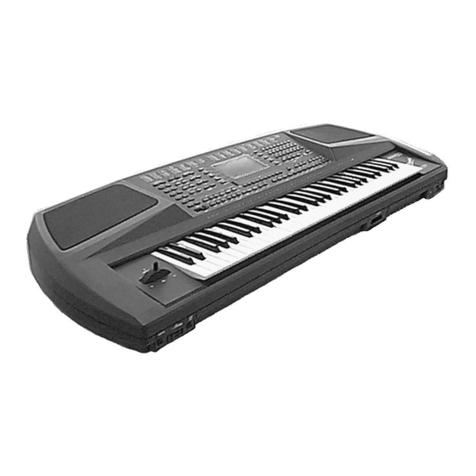
KETRON
KETRON X1 Supplementary instructions

Dave Smith Instruments
Dave Smith Instruments Mopho SE Operation manual

Native Instruments
Native Instruments Absynth 5 Reference manual
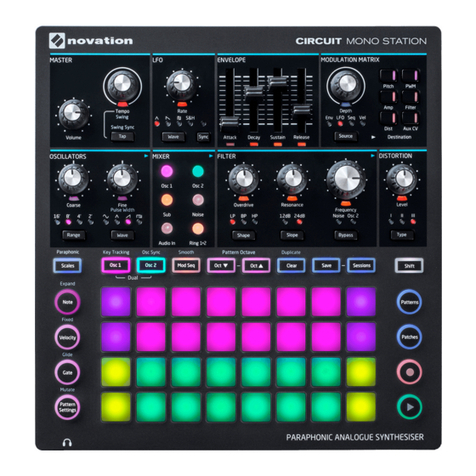
Novation
Novation Circuit Mono Station user guide

mikroElektronika
mikroElektronika BassBoy manual
